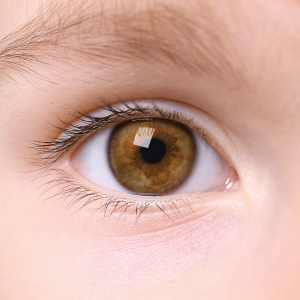Your Child’s Eye Health: What You Need to Know
THE EYE CARE EDITION
Your Child’s Eye Health:
What You Need to Know
By Optometrist, Renee Slunkski

Visiting the Optometrist should be on your priority list for your child’s health care screenings, much like your GP or Dentist visits. Having your children’s eyes checked early creates a baseline for their vision and your Optometrist will be able to pick up conditions early that develop over time and treat them accordingly.
Our eyes are complex organs, not only does the eye need to develop itself, but it also needs to coordinate with the other eye to develop good binocular vision, which is important for depth perception (3D vision) and peripheral vision.
How children see
Almost every baby is born hyperopic (long-sighted), and this is something we grow out of by the age of five. However, a genetic cause, family history or environmental factors can disrupt normal development of the eye and a child may not ‘grow out’ of their long- sightedness. Symptoms can include eye turns (strabismus), squinting, trouble focusing, headaches and eyestrain. Hyperopia can be diagnosed by an Optometrist, commonly requiring the use of an eye drop to temporarily dilate your child’s pupil and disable the focusing component of the eye so that we can perform an objective examination. If hyperopia or another condition such as astigmatism, myopia, droopy eyelid, squint or eye turn, is not diagnosed, your child may develop amblyopia, otherwise known as lazy eye.
Common eye conditions of neglected eyes
Ages 0-7 are a critical time for your child’s eye health, so if their vision is not corrected in this period they can develop a weaker eye which will not see as well as the other ever again. This can have implications on what career your child can go into, and means they don’t have 3D perception which we need as we grow older for hand-eye coordination, driving and other daily tasks.
Another common eye condition is myopia, or short-sightedness. It is estimated that myopia affects 80 million children worldwide, a figure which is expected to rise rapidly to 9.8 percent of the global population by 2050¹. This condition affects a person’s long-distance vision; this has increased over the decade with use of close screens, which neglects development of distance vision. Symptoms can include holding objects close to the eyes, moving closer to the TV or board in a classroom, reduced performance at school, squinting and tired eyes or headaches. Along with extended periods of near work, myopia can also be inherited – if both parents have it, there’s a 50 percent chance it can be passed onto children, or 25 percent if one parent is myopic.²
Along with the need for glasses or contact lenses, complications like retinal detachment, myopic macular degeneration and glaucoma are more likely, ³ so you want to slow down the progression as soon as possible. Our Optometrists recommend eye tests from the age of three to keep track of expected milestones, and annual examinations if there is a family history of myopia, or other visual problems.
Glasses with a graded lens that helps focus on various distances have been developed that slow down the progression of myopia. Contact lenses have also been designed which help slow down myopia progression. A third method in conjunction with glasses or contact lenses is low-dose Atropine eye drops, prescribed by your Optometrist.
Eye tests from an early age are vital to detect these common eye conditions and optimise your child’s eye development. Our Optometrists have a variety of enjoyable, interactive tests they can use to assess your child’s vision including colour and 3D perception, picture-naming, tracking and comprehensive eye health assessments including a photograph of the back of the eye.
References
1. Williams K, Hammond C., High myopia and its risks. Community Eye Health. 2019;32(105):5-6.
2. Morgan P., Is Myopia Control the Next Contact Lens Revolution? The Optician 2016.
3. Annechien E. G. Haarman, Clair A. Enthoven, et al., The Complications
of Myopia: A Review and Meta-Analysis. Invest.
Ophthalmol. Vis. Sci. 2020;61(4):49.